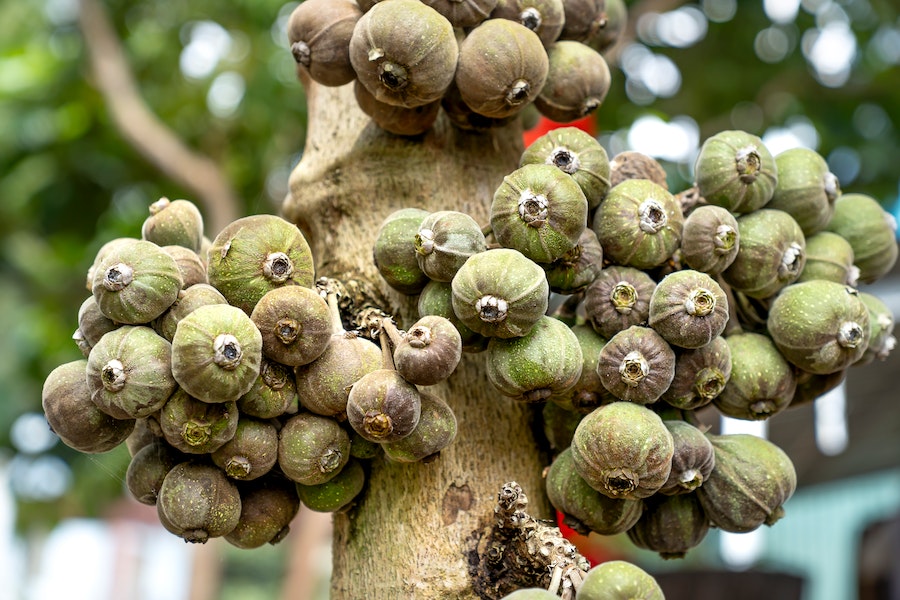Propagating a fig tree is a rewarding horticultural endeavor that allows you to create new trees from existing ones, share the fig tree love with friends, or replace aging trees. Whether you’re a seasoned gardener or a beginner, understanding the art of fig tree propagation is a valuable skill. In this informative guide, we’ll explore the what, how, and why of propagating fig trees. You’ll learn about the methods, and step-by-step instructions, and get answers to common questions, empowering you to grow your own lush fig garden. Let’s embark on this fruitful journey together!
How To Propagate A Fig Tree?
1. Propagation By Cuttings:
Select healthy, woody branches from the parent fig tree. Cut the branches into 6-10 inch pieces, making sure each cutting has at least one node. Remove leaves from the lower half of the cutting. Plant the cuttings in a well-draining potting mix or directly in the ground. Keep the soil consistently moist, and the cutting should root within a few weeks to months.
2. Air Layering:
Select a healthy branch on the parent fig tree. Make a shallow incision or remove a ring of bark about 12-18 inches from the tip of the branch. Wrap the wounded area with moist sphagnum moss or peat moss, covering it with plastic wrap. Secure the moss and plastic in place with twine or rubber bands. Once roots develop in the moss, cut the branch below the rooted area and transplant it.
3. Propagation From Suckers:
Identify suckers, which are shoots that emerge from the base of the parent fig tree. Gently separate the sucker from the parent tree, ensuring it has some roots attached. Transplant the sucker into a new location or container with well-draining soil. Water the transplanted sucker regularly until it establishes itself.
4. Grafting:
Choose a healthy fig tree (the rootstock) and a desired fig variety (the scion).
Make a diagonal cut on both the rootstock and scion, creating a matching V or whip-and-tongue shape. Join the two pieces together, ensuring the cambium layers align. Secure the graft with grafting tape or rubber bands. Keep the grafted tree in a controlled environment until it heals and begins to grow.
5. Propagation By Division:
Dig up an established fig tree and carefully divide it into multiple sections.
Each section should have its roots and stems. Replant the divided sections in suitable locations or containers. Water them well and monitor their growth. Choose the propagation method that best suits your preferences and circumstances, and enjoy the process of growing new fig trees in your garden.
When Is The Best Time To Propagate A Fig Tree?
The timing for propagating a fig tree plays a crucial role in its success. Fig trees can be propagated during specific seasons, and the choice depends on the method you plan to use.
Spring is generally the best time for propagating fig trees using methods like propagation by cuttings or air layering. During this season, the parent fig tree is actively growing, which means it has the energy and resources to support the development of new shoots and roots. The mild temperatures and increased sunlight also create ideal conditions for successful propagation. As the weather warms up, the cuttings or air layers have a better chance of rooting and establishing themselves.
In some regions with mild winters, late winter, just before the onset of spring, can be a suitable time for propagation. This timing allows you to take advantage of the plant’s natural growth cycle while avoiding the risk of harsh winter conditions. It’s crucial to ensure that the fig tree is still dormant or just starting to wake up from its winter slumber when propagating in late winter.
Early fall can be a viable time for propagating fig trees, primarily through propagation by cuttings. During this season, the tree is transitioning from its active growth phase to dormancy. By taking cuttings before the first frost but after the tree has stopped actively growing, you can allow them to develop roots slowly over the winter, ready to burst into growth when spring arrives.
What Type Of Soil Should I Use For Fig Tree Cuttings?
When propagating fig tree cuttings, it’s essential to provide the right type of soil to encourage successful rooting and healthy growth. Fig trees prefer a well-draining, slightly sandy, and nutrient-rich soil mixture. Here’s a recommended soil mixture for fig tree cuttings:
- Soil Mix: Combine equal parts of well-draining garden soil and coarse sand or perlite. You can also add organic matter, such as compost or aged manure, in small amounts to enrich the soil mixture and improve its fertility.
- Sand or Perlite: Adding sand or perlite helps improve the soil’s drainage, preventing waterlogging and root rot. The coarse texture of these components ensures that excess water can drain away easily.
- Organic Matter: While fig trees are not heavy feeders, incorporating a small amount of well-rotted compost or aged manure can provide essential nutrients and improve soil structure. Do not overdo it with organic matter, as fig tree cuttings are sensitive to overly rich soil.
- pH Level: Ensure that the pH level of the soil mixture is slightly acidic to neutral, typically in the range of 6.0 to 7.0. You can adjust the pH level by adding lime to raise it or sulfur to lower it if necessary.
- Sterilization: It’s a good practice to sterilize the soil mixture before using it for fig tree cuttings to prevent the introduction of pathogens and pests. You can sterilize the soil by heating it in an oven at 180-200°F (82-93°C) for about 30 minutes.
- Containers: Plant your fig tree cuttings in well-draining containers or pots filled with this soil mixture. Make sure the containers have drainage holes to allow excess water to escape. Remember to keep the soil consistently moist but not waterlogged during the rooting process. Proper soil preparation and care will greatly enhance the success of propagating fig tree cuttings.
Conclusion
In conclusion, propagating fig trees is a gratifying journey that allows you to nurture new growth and share the beauty of this beloved fruit-bearing tree. By understanding the best propagation methods, timing, and soil requirements, you can embark on this horticultural adventure with confidence. Whether you choose to propagate through cuttings, air layering, or other methods, your efforts will be rewarded with the joy of watching your fig tree flourish and bear delicious fruits. So, roll up your sleeves, get your hands dirty, and let the propagation process lead you to a fruitful future in your garden. Happy gardening!
FAQs
When Is The Best Time To Propagate A Fig Tree?
The best time is typically in spring when the tree is actively growing, or in late winter just before spring begins.
Can I Propagate A Fig Tree From Store-Bought Figs?
While it’s possible, it can be challenging. Fig trees from store-bought figs may not always produce true-to-type trees.
How Long Does It Take For Propagated Fig Trees To Bear Fruit?
It can take a few years, typically 2-3, for propagated fig trees to mature and start producing fruit.
What Type Of Soil Should I Use For Fig Tree Cuttings?
Use a well-draining mixture of garden soil and sand or perlite, with a slightly acidic to neutral pH.
Can I Propagate A Fig Tree From A Mature Tree’s Branches?
Yes, you can propagate fig trees from mature branches using methods like cuttings, air layering, or grafting.
















Leave a Reply